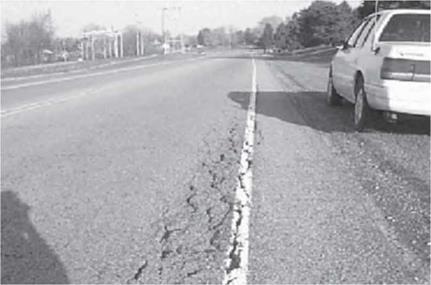Fog Sealing
A fog seal is an application of a diluted asphalt emulsion to a weathered asphalt surface. It is used to seal and enrich the surface, seal out moisture, close up hairline cracks, and prevent oxidation and raveling. Fog seals are generally restricted to low-volume, low-speed roadways and parking lots, as they have a tendency to cause loss of friction for a short period of time after application. Fog seals should only be used on sufficiently weathered pavements that have the ability to absorb the asphalt emulsion. Fog seals should be placed on dry, clean pavements, when temperatures are warm or hot. Traffic should be kept off the fog seal until the emulsion has cured. Up to 3 h may be necessary to ensure sufficient cure. Fog seals can be expected to last as long as 3 years.
Chip seal is a sprayed application of a polymer-modified asphalt binder covered immediately by a washed limestone, dolomite aggregate, or trap rock and rolled with a
pneumatic roller. The binder is applied by an approved bituminous distributor, and the aggregate placed by an approved aggregate spreader. The rolling operation is intended to seat the aggregate into the binder and ensure chip retention. Chip seals can be placed as single or double applications, depending on pavement condition. Chip seal is most generally applied to low-volume roadways, but has been applied to roadways with average daily traffic levels (ADTs) as high as 30,000. Chip seals are intended to provide a new wearing surface as well as to eliminate raveling, retard oxidation, reduce the intrusion of water, improve surface friction, and seal cracks.
Chip seals should only be applied to pavements that are structurally sound and suitable for preventive maintenance. The following conditions should be given careful consideration prior to a chip seal:
• Localized wheel track cracking should be repaired full depth.
• Any potholes must be repaired full depth.
• Areas which exhibit debonding must be patched partial depth.
• All existing patches must be in good repair prior to chip sealing.
• All existing cracks must be crack-sealed prior to chip sealing.
• Localized high-severity edge cracking must be repaired full depth (see Fig. 3.56) prior to a chip seal.
• Rutting must be no more than 1/8 in (3 mm) deep.
Traffic should be restricted and speeds reduced to minimize the loss of chips from the pavement surface. Length of time for traffic restrictions depends largely on ambient weather conditions at the time of construction of the chip seal. The construction season for this work is relatively short. Chip seals should not be placed in cool weather. It usually requires about 1 month of warm weather following construction for the aggregate
|
FIGURE 3.56 Localized edge cracking must be repaired full depth before chip sealing. |
particles to become reoriented and properly embedded in the asphalt membrane. The expected service life of a chip seal is 5 to 7 years.







Leave a reply